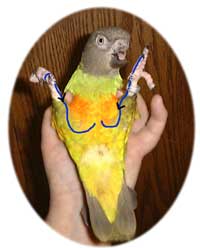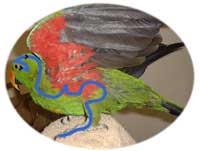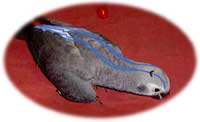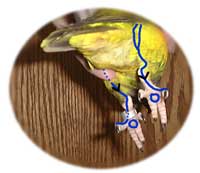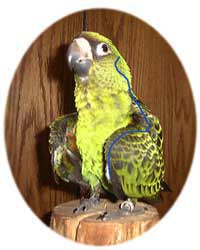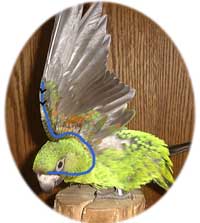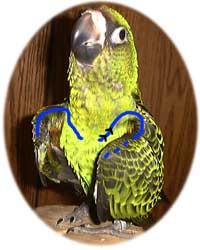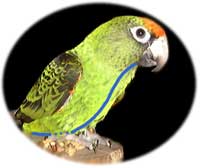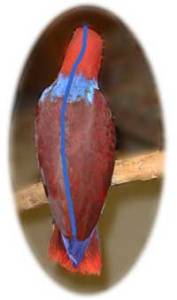by gloria scholbe
December 2001
Pathways of Qi | Directions and Partners | Meridian Line Images (Liver and Gall Bladder; Kidney; Pericardium and Urinary Bladder;Stomach, Spleen, and Heart; Small intestine; Large intestine, and Lung; Triple Heater; Governing and Conception Vessels) Acupoints | References
Pathways of Qi
According to Traditional Chinese Medicine (TCM), each living body possesses life force energy. In Western terms it is translated as electrical energy. This energy (Qi or Ch’i – pronounced chee) is used by the body to perform its various functions.
Qi is replenished by food, water, and air. As long as Qi continues to flow freely along its energy channels (meridians), the body remains healthy. If Qi becomes deficient, stagnant, rebellious, or collapses, the body becomes unhealthy and may even die.
The meridian system is composed of fourteen major pathways (energy channels) which conduct the flow of Qi. The cells within meridians contain ten times the amount of sodium and potassium found in regular cells. This makes them excellent conductors of the body’s electricity.
Twelve meridians run in pairs throughout the body. Pairs means that when one line of a meridian pair runs along the inner right wing, the other line of the pair will run along the inner left wing, and so on. Two of the major meridians are unpaired. They are the Conception vessel and the Governing vessel.
Directions and Partners
Each meridian connects to a specific organ. Six organs are yin and six are yang. Each yin organ is partnered with a yang organ. Yin organs are characterized by being solid whereas their partner yin organs are characterized by being hollow. Hollow organs are containers for things like food, waste, and bile.
Qi flows in opposite directions in yin and yang partners. It flows from the meridian’s starting point, to the ending point. One meridian line ends near where its yin or yang partner begins. In this way, meridians unite the entire body into a functioning whole through which Qi flows freely in a healthy body.
It is useful to know which direction Qi flows along a particular meridian when using a therapy such as magnets, touch, or laser lights. Moving in the direction of the flow along a meridian line will stimulate the energy. Moving the tool in the direction opposite to normal flow will help to quiet the energy, balance it, or even correct the direction of flow (as in rebellious Qi, which flows opposite to its normal direction. An example of this would be involuntary regurgitation.)
This table lists the yin/yang partners and Qi’s direction of flow. Click on the meridian’s name to view the diagram.
| name | abbr. | type | start | end at acupoint |
| Liver | LIV | yin | From inside back toe, up inside leg to | upper abdomen LIV-14 |
| Gallbladder | GB | yang | From head down outside leg to | outside front toe GB-44 |
| Spleen -Pancreas | SP | yin | From inside back toe, up inside leg to | side of chest SP-21 |
| Stomach | ST | yang | From under eye, down abdomen, down front of leg to | inside back toe ST-45 |
| Heart | HT | yin | From between shoulder/chest, to along under-wing to | wing tip HT-9 |
| Small intestine | SI | yang | From wing tip, to outside wing and shoulder to | ear SI-19 |
| Lung | LU | yin | From upper front chest/shoulder, to wing pit, then along underside of wing | wing tip LU-11 |
| Large intestine | LI | yang | From wing tip, top edge of wing, shoulder to | nares LI-20 |
| Kidney | KI | yin | From bottom of foot where toes converge, up inside leg to | upper front chest KI-27 |
| Urinary Bladder | BL | yang | From eye, over skull, down along spine, then ack of leg to | outside back toe BL-67 |
| Pericardium | P | yin | From upper front chest, along inside wing to | wing tip P9 |
| Triple Heater (glands) | TH | yang | From wing tip, along top of wing, up shoulder and neck to | eye TH-23 |
| Conception vessel | CV | most yin | From below vent along center of ventral side of the body to | below lower mandible CV-17 |
| Governing vessel | GV | most yang |
From between vent and tailbone up along spine and over skull to | above upper mandible GB-26 |
Note: The 12 week old baby Jardine’s in the following photos is going through an affection/solicitation phase. His ‘droopy’ wings demonstrate ‘posturing’ body language and are not an indication of poor health.
From inside back toe, up inside leg to upper abdomen.
Problems associated with Liver and Gallbladder meridians include: eye and vision, conjunctivitis, liver problems, poor digestion, body dryness and itchiness, weak pulse, regurgitation, hernia, urination problems, pain in the lower abdomen and along the course of the meridian.
From head, down outside leg to outside front toe
In addition to the problems listed under Liver, Gall Bladder meridian contains points for ear and hearing, neck, upper respiratory, shoulder, infertility, kidney disorders, pain along the course of the meridian.
From bottom of foot where toes converge, (see bottom photo) up inside leg to upper front chest.
Kidney, bladder, and reproductive disorders; lung problems, dry tongue, shock, fever, edema, constipation, diarrhea, pain and weakness along the course of the meridian
KI-1 (bottom of foot) is the sedation point of the kidney meridian for shock and fever.
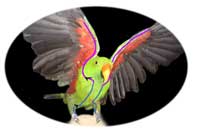 Pericardium Meridian
Pericardium Meridian
(purple line)
From upper front chest, along inside wing to wing=tip
poor circulation, chest pain, diseases of the sexual glands and organs, wing pain, irritability, pain along the course of the meridian.
From eye, skull, down along spine, back of leg to outside back toe (bottom photo). This meridian splits into two lines, so the UB pair contains four lines.
Headache, eye diseases, neck and back ailments, bladder problems, pain along the back of the leg, fever, healing bones, lung congestion, heart problems, foot problems, pain along the meridian.
From under eye, around jaw, down abdomen, front of leg to outside back toe.
Stomach problems, digestion, abdominal pain and distension, edema, vomiting, facial paralysis, jaw pain, eye problems, bleeding nares, fertility problems, pain along the meridian. ST-45 is the sedation point of this meridian.
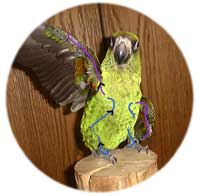 Spleen/ Pancreas Meridian
Spleen/ Pancreas Meridian
(blue line)
From inside back toe, up inside leg to side of chest
Problems of the spleen and pancreas, abdominal swelling, reproductive disorders, prolapse, jaundice, chronic conditions, gastrointestinal and urinary problems, cold / sluggish / lethargic, lung and skin, tongue problems, regurgitation, pain and swellings along the course of the meridian
From shoulder/chest, to along under wing to wing tip.
Heart problems, dryness of the throat, jaundice, pain in shoulder and wing along the course of the meridian
From wing tip, to outside wing and shoulder to ear
Pain in the lower abdomen, swelling or paralysis of face, and jaw, deafness, fever, anemia, shoulder and wing problems, pain along the meridian
From wing tip, top edge of wing, shoulder to nares.
Abdominal pain, constipation, diarrhea, nasal discharge and bleeding, sinusitis, pneumonia, wing problems, fever, jaw problem, pain along the course of the meridian
From upper front chest/shoulder, to wing pit, underside of wing to tip.
Lower respiratory diseases, including bronchitis, pneumonia, response to grief and allergies, head and neck, pain in the shoulder and along the meridian
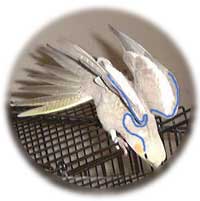 Triple Heater
Triple Heater
(glands / endocrine system)
From wing tip, along top of wing, up shoulder and neck to the eye.
Diseases of the thyroid and adrenal glands, ear problems, sore throat, foot problems, brain inflammation, reproductive disorder, abdominal swelling, edema, swelling of cheek and mandible, pain along the meridian
From below vent along center of ventral side of the body to below the center of the lower mandible.
Diseases of the urinary and genital systems, stomach disorders, diarrhea, respiratory problems.
From between vent and tailbone up along spine and over skull to above the center of the upper mandible.
spinal problems, convulsions, mental disorders, fever, sinus, headaches , back pain, constipation, prolapse, reproductive, respiratory, and gastrointestinal disorders, skin disorder.
Pressure at GV-26, the point just above the center of the upper mandible and below the nares, may restore a victim in deep shock that is close to death.
Acupoints
Acupoints are located along meridian lines. The number of points on each meridian line varies. Each point has influence over some organ, organ function or overall condition of the body. If you have been reading the information accompanying the diagrams, you can see that meridian lines contain acupoints which influence organs other than those reflected by the meridian’s name. For example, the Large Intestine meridian has points that influence the eyes, the lungs, the wings, and other body organs in addition to the large intestines. An indication of which organ a particular acupoint controls is where it is located. An acupoint located near an eye may influence health of that eye.
Acupoints can be felt as slight depressions under the skin. In her book Four Paws Five Directions, Cheryl Schwartz describes them as meridian “on/off ramps that exit to the skin’s surface. Each exit point has a very small diameter, and yet is an area of greatly increased electrical conductivity compared to the surrounding skin area.”
Sensitivity to pressure at one of these points is an indication that the organ with which it is associated is in trouble. Acupoints are used for both diagnosis and treatment.
Treatment of specific points involves mainly acupressure or acupuncture. An acupressure practitioner would locate the sensitive point and apply pressure and/or massage to it with one or more fingertips. Since the point is sensitive, this pressure can cause some degree of pain. Therefore, this technique is not always possible with some nimal patients.
Acupuncture involves the use of special needles, which are inserted into related points and manipulated. Some animal patients tolerate this well and others do not. This technique requires the services of a trained acupuncturist.
Acupuncturists are trained not only in the insertion of needles, but in the knowledge of which points to stimulate for which condition. The correct selection of points often involves a ‘formula’, which combines specific points from different meridians. For example, a point formula to treat chronic respiratory infections would include: BL-13, CV-17, LU-7, L-I4, and LI-20. The trained acupuncturist has thorough knowledge of the characteristics of each point and what its effect will be when combined with other points.
Home Therapy
Low level laser therapy or magnet therapy is ideal for birds, since neither involves pain nor restraint. It is also ideal because it can be practiced at home by any bird owner who makes the effort to study meridian lines.
Home therapy cannot take the place of deep healing, which is accomplished with acupuncture. However, if used appropriately, it is a great tool for low level conditions such as pain, wounds, chronic infections, general malaise, and possibly to stimulate feather follicles.
Please read Angela Carpenter’s article about Low Level Laser Therapy.
References:
Peggy Fleming, Equine Acupuncture, Complimentary and Alternative Veterinary Medicine edited by Allen Schoen and Susan Wynn
John Limehouse and Pricilla Taylor, Traditional Chinese Medical Theory, Complimentary and Alternative Veterinary Medicine edited by Allen Schoen and Susan Wynn
David McCluggage, Holistic Medicine in Exotic Species Practice, Complimentary and Alternative Veterinary Medicine edited by Allen Schoen and Susan Wynn
Cheryl Schwartz, Four Paws Five Directions
Diane Stein, Natural Remedy Book for Dogs and Cats
Diane Stein, Natural Healing for Dogs and Cats

